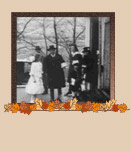| 
A movie is a visual document comprised of a series of still images.
This media format captures multiple moments in time. Spoken dialogue,
sound effects, and music add meaning to the images. Movie files
can provide lasting witness to historic events, special occasions,
or family happenings. Although today's students are frequently "tuned-in"
to this medium, they may have had little practice in learning how
to analyze what they view. The American Memory collections include
late-19th and early-20th century movie files. Many of these relate
to holiday and seasonal events in the United States. View this
1917
movie of Theodore
Roosevelt calling on his neighbors at Christmas. Analyze the
film using the observe, think, and ask process. Use the following
questions to guide your students' analysis or create questions
of
your own. Have students take notes using the graphic organizer.
• Observe: Prior to showing the movie, provide students
with background information including title, location, and date
of the filming. Based on this information, ask what they might expect
to see. Ask them to decide what type of motion picture this might
be (documentary, newsreel, dramatization, etc.) Have them watch
for physical qualities (music, narration, special effects, live
action, background noise, animation, or dramatization). View the
movie. Who are the people being filmed? Are any of them familiar
faces? How are they dressed? What is happening in the movie? During
what season was the movie filmed? What other clues in the film provide
information about the culture, customs, and styles of the time?
• Think: After viewing the film, draw on students' prior
knowledge. Who was Teddy Roosevelt? Where is Oyster Bay, New York?
What was happening in the United States in 1917? Why would someone
have wanted to film this event? Did the filmmaker have a message?
How did watching the film make the student feel? What did students
learn by watching the film?
• Ask: Viewing a silent film can leave students with
many unanswered questions. Ask students to think about what they
need to know in order to better understand the movie. Would visiting
neighbors on Christmas have been a common occurrence for a president?
Were these neighbors special friends? Why was the president in Oyster
Bay? What written sources could students consult to find out more
about Theodore Roosevelt and this time period? In addition, help
students make connections to the present. Does our current president
visit neighbors? How could they find out?
Movies will continue to be a major influence in our students' lives. Learning
to analyze films from the past will provide students with tools to better understand
current media. After viewing the holiday-related films listed on the left side
of this page, search the
American Memory collections for more films. Select "motion pictures"
from the "Limit Search to:" box on the right side of the search page.
American Memory viewing
and downloading tips will be
helpful in this activity.
|

